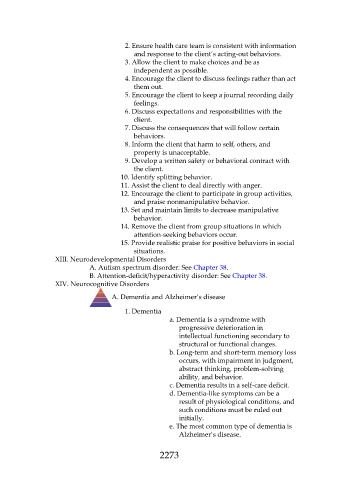Page 2273 - Saunders Comprehensive Review For NCLEX-RN
P. 2273
2. Ensure health care team is consistent with information
and response to the client’s acting-out behaviors.
3. Allow the client to make choices and be as
independent as possible.
4. Encourage the client to discuss feelings rather than act
them out.
5. Encourage the client to keep a journal recording daily
feelings.
6. Discuss expectations and responsibilities with the
client.
7. Discuss the consequences that will follow certain
behaviors.
8. Inform the client that harm to self, others, and
property is unacceptable.
9. Develop a written safety or behavioral contract with
the client.
10. Identify splitting behavior.
11. Assist the client to deal directly with anger.
12. Encourage the client to participate in group activities,
and praise nonmanipulative behavior.
13. Set and maintain limits to decrease manipulative
behavior.
14. Remove the client from group situations in which
attention-seeking behaviors occur.
15. Provide realistic praise for positive behaviors in social
situations.
XIII. Neurodevelopmental Disorders
A. Autism spectrum disorder: See Chapter 38.
B. Attention-deficit/hyperactivity disorder: See Chapter 38.
XIV. Neurocognitive Disorders
A. Dementia and Alzheimer’s disease
1. Dementia
a. Dementia is a syndrome with
progressive deterioration in
intellectual functioning secondary to
structural or functional changes.
b. Long-term and short-term memory loss
occurs, with impairment in judgment,
abstract thinking, problem-solving
ability, and behavior.
c. Dementia results in a self-care deficit.
d. Dementia-like symptoms can be a
result of physiological conditions, and
such conditions must be ruled out
initially.
e. The most common type of dementia is
Alzheimer’s disease.
2273

